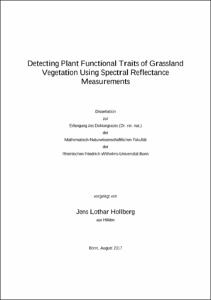Detecting Plant Functional Traits of Grassland Vegetation Using Spectral Reflectance Measurements

Detecting Plant Functional Traits of Grassland Vegetation Using Spectral Reflectance Measurements

| dc.contributor.advisor | Schellberg, Jürgen | |
| dc.contributor.author | Hollberg, Jens Lothar | |
| dc.date.accessioned | 2020-04-25T00:01:55Z | |
| dc.date.available | 2020-04-25T00:01:55Z | |
| dc.date.issued | 06.03.2018 | |
| dc.identifier.uri | https://hdl.handle.net/20.500.11811/7511 | |
| dc.description.abstract | Changes in climate and an intensified agricultural use threaten grassland ecosystems in many places. To allow an efficient conservation of grassland vegetation communities, ecologists monitor variations in their plant functional traits (FTs). FTs are morphological, physiological or phenological properties of plants, which are measured at the individual plant level. However, manual measurements of FTs are costly as well as time-consuming and often require destructive sampling techniques. Grassland ecologists and agronomists are thus seeking for novel methods to monitor and map grassland FTs. Remote sensing (RS) may provide a solution to the mentioned problems and allows to collect spatially contiguous and multitemporal information on FTs. To test the performance of RS systems for detecting FTs, the Rengen Grassland Experiment in Germany was selected as study site. Due to more than 70 years of constant fertilization along a gradient from limed only to fully fertilized (treated with lime, nitrogen, phosphorus and potassium), five different plant communities have developed, which differ in their FTs. The spectral reflectance of these plant communities was collected for a period of three years using an ASD Field Spec 3 (FS3) spectroradiometer. Furthermore, 23 different FTs were measured using manual sampling methods. Firstly, it was investigated if and how the five grassland communities can be distinguished using 15 different remotely sensed vegetation indices (VIs). It was found that the performance of single VIs for differentiating the studied plant canopies fluctuates over time. Consequently, it was not possible to distinguish the communities with high accuracy throughout all phases of their phenological development using one VI. To solve this problem, a multi-VI approach using the random forests algorithm is proposed, which automatically selects the ideal sets of VIs for distinguishing grasslands. This technique allows a stable and accurate classification of grassland communities for the entire growing season. Secondly, it was studied how well the FTs of the different grassland communities can be estimated based on FS3 data. Using partial least squares regression (PLSR) it was possible to create one single model for estimating one FT of all studied grassland canopies at all phenological stages based on the spectral reflectance. Among the 23 investigated FTs, nine were modelled with R squared in validation (R2val) larger than 0.6, four with R2val larger than 0.4 and 10 with R2val lower than 0.4. It is concluded that RS allows a cost-efficient, time-saving and non-destructive monitoring of many FTs for a range of plant communities. Thirdly, the potential of different RS systems for detecting FTs was assessed. Based on spectral reflectance data recorded with a full-range FS 3, the bands of two hyperspectral and three multispectral RS sensors were simulated. Using PLSR and hyperspectral RS, 13 FTs were modeled with R2val larger than 0.4 using FS 3, 11 using EnMAP and ten using ASD HandHeld 2 data. Based on multispectral information, R2val larger than 0.4 were reached with Sentinel-2 for nine, Landsat 7 for four and RapidEye for none of the 23 FTs. These results show that hyperspectral RS systems outperform multispectral systems in detecting the FTs of grassland vegetation. It is concluded that hyperspectral RS systems have the potential to collect spatio-temporal information on grassland FTs. Such information may support grassland scientists in adapting the management to changes in climate and land-use intensity and to secure a sustainable agricultural production. | en |
| dc.language.iso | eng | |
| dc.rights | In Copyright | |
| dc.rights.uri | http://rightsstatements.org/vocab/InC/1.0/ | |
| dc.subject | Fernerkundung | |
| dc.subject | Feldspektrometrie | |
| dc.subject | funktionale Merkmale | |
| dc.subject | hyperspektral | |
| dc.subject | Grünland | |
| dc.subject | Grasland | |
| dc.subject | Klassifikation | |
| dc.subject | Vegetationsindex | |
| dc.subject | multitemporal | |
| dc.subject | Remote sensing | |
| dc.subject | hyperspectral | |
| dc.subject | field spectrometry | |
| dc.subject | classification | |
| dc.subject | random forest | |
| dc.subject | vegetation index | |
| dc.subject | multitemporal | |
| dc.subject | partial least squares regression | |
| dc.subject.ddc | 910 Geografie, Reisen | |
| dc.title | Detecting Plant Functional Traits of Grassland Vegetation Using Spectral Reflectance Measurements | |
| dc.type | Dissertation oder Habilitation | |
| dc.publisher.name | Universitäts- und Landesbibliothek Bonn | |
| dc.publisher.location | Bonn | |
| dc.rights.accessRights | openAccess | |
| dc.identifier.urn | https://nbn-resolving.org/urn:nbn:de:hbz:5n-49923 | |
| ulbbn.pubtype | Erstveröffentlichung | |
| ulbbnediss.affiliation.name | Rheinische Friedrich-Wilhelms-Universität Bonn | |
| ulbbnediss.affiliation.location | Bonn | |
| ulbbnediss.thesis.level | Dissertation | |
| ulbbnediss.dissID | 4992 | |
| ulbbnediss.date.accepted | 19.01.2018 | |
| ulbbnediss.institute | Mathematisch-Naturwissenschaftliche Fakultät : Fachgruppe Erdwissenschaften / Geographisches Institut | |
| ulbbnediss.fakultaet | Mathematisch-Naturwissenschaftliche Fakultät | |
| dc.contributor.coReferee | Greve, Klaus |
Files in this item
This item appears in the following Collection(s)
-
E-Dissertationen (4306)




